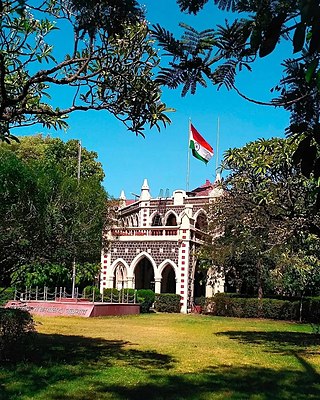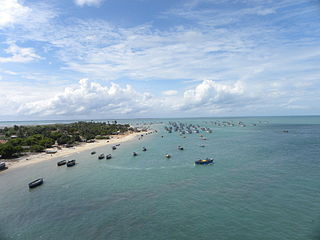Related Research Articles

Kanyakumari is a city in Kanyakumari district in the state of Tamil Nadu, India. It is the southernmost tip of the Indian subcontinent and the southernmost city in mainland India, and thus referred to as "The Land's End". The city is situated 90 kilometres (56 mi) south of Thiruvananthapuram city, and about 20 kilometres (12 mi) south of Nagercoil, the headquarters of Kanyakumari district.

Nagercoil, also spelt as Nagarkovil, is a city and the administrative headquarters of Kanyakumari District in Tamil Nadu state, India. Situated close to the tip of the Indian peninsula, it lies on an undulating terrain between the Western Ghats and the Arabian Sea.

Panchamrita is a mixture of five foods used in Hindu as well as Jain worship and puja and Abhiṣeka It is often used as an offering during pooja post which it is distributed as prasad.

Kanyakumari district, officially Kanniyakumari district, is one of the 38 districts of Tamil Nadu state and the southernmost district in mainland India. It stands second in terms of population density among the districts of Tamil Nadu. It is also the richest district in Tamil Nadu in terms of per capita income, and also tops the state in Human Development Index (HDI), literacy, and education. The district's headquarters is Nagercoil.

Marayur or Marayoor is a town in Devikulam taluk of Idukki district in the southwestern Indian state of Kerala. It is located 42 kilometers north of Munnar on SH 17 connecting Munnar with Udumalpet, Tamil Nadu. Marayur is situated at around 990 metres above mean sea level and is the only place in Kerala that has natural sandalwood forests. Ancient dolmens and rock paintings in Marayur date back to the Stone Age. In 1991 Marayur had a population of 9,590.

Vellore district is one of the 38 districts in the Tamil Nadu state of India. It is one of the eleven districts that form the north region of Tamil Nadu. Vellore city is the headquarters of this district. As of 2011, the district had a population of 1,614,242 with a sex ratio of 1,007 females for every 1,000 males. In 2017 Vellore district ranked eleventh in list of districts in Tamil Nadu by Human Development Index.

Jalgaon district is a district in Maharashtra, India. Its headquarters is the Jalgaon city.

Ramanathapuram District, also known as Ramnad District, is one of the 38 districts an administrative districts of Tamil Nadu state in southern India. The old Ramanathapuram District consists of Present day Virudhunagar and Sivagangai districts, it touches the Western ghats and bordered with the state of Kerala and east by Bay of Bengal. It was the largest district on that time. The town of Ramanathapuram is the district headquarters. Ramanthapuram District has an area of 4,123 km2. It is bounded on the north by Sivaganga District, on the northeast by Pudukkottai District, on the east by the Palk Strait, on the south by the Gulf of Mannar, on the west by Thoothukudi District, and on the northwest by Virudhunagar District. The district contains the Pamban Bridge, an east–west chain of low islands and shallow reefs that extend between India and the island nation of Sri Lanka, and separate the Palk Strait from the Gulf of Mannar. The Palk Strait is navigable only by shallow-draft vessels. As of 2011, Ramanathapuram district had a population of 1,353,445 with a sex-ratio of 983 females for every 1,000 males. The district is home to the pilgrimage centre of Rameswaram and tourist spot Dhanushkodi, an abandoned town.

Agaçaim or Agassaim, is a village on the northern banks of the Zuari River in Tiswadi, Goa, surrounded by Panjim to the north, Margão to the south, Vasco da Gama to the west and Ponda to the east, thus making it a main connection between North Goa and South Goa via the Zuari Bridge. Agaçaim is famous for its Goan chouriço.

Sanjai Gandhi is an attorney at law specializing at intellectual property rights. Gandhi had been instrumental in getting protection under Geographical Indication Act, 1999 for more than 15 Geographical indications (GI) for the state of Tamil Nadu, India. The products for which IPR attorney Sanjai Gandhi has obtained GI protection are: Kancheepuram Silk Sarees, Bhavani Jamakkalam (bedsheet), Madurai Sungudi Saree, Salem White Silk, Kovai Cora Cotton, Arani Sari, Thanjavur Paintings, Thanjavur Dancing Doll, Ethomozhi Tall Coconut of Kanyakumari district and Tangaliya Shawl of Gujarat, Thanjavur Veenai, Mahabalipuram Stone Sculpture, Thirubuvanam Silk Sarees, Dindigul Locks, Srivilliputtur Palkova, Kandangi Saree, Arumbavur Wood Carving, and Thanjavur Pith Work.

Erode Turmeric or Erodu Manjal is a type of turmeric, a spice category which is grown in the Erode region of Tamil Nadu, India. It has been recognized as a Geographical indication by the Government of India in 2019. Erode turmeric is known for its high curcumin (>90%).
Sirumalai Hill Banana is a type of banana grown in the Sirumalai region in the Palani Hills of Western Ghats in the Indian state of Tamil Nadu. It was declared as a Geographical indication in 2008–09.

Palani Panchamirtham is a type of panchamrita, an Indian sweet, and Prasadam of the Dhandayuthapani Swamy Temple in Palani in the Indian state of Tamil Nadu. It was declared as a Geographical indication in 2019-20 and was the first temple prasadam to be accorded the status.
The 'Mankurad' mango, is a mango cultivar primarily grown in the coastal state of Goa, India. It is also cultivated in Vengurla and Malvan talukas of Maharashtra along within Uttara Kannada district of Karnataka. Malcorado, Mancurad, Mankur, Kurad, Corado are variations of the same name. Mankurad varieties include the Cardozo Mancurad, Costa Mancurad, Gawas Mancurad, and Amaral Mancurad.

The Ramanathapuram Mundu chilli is a variety of dry red chilli mainly grown in Ramanathapuram district, of the Indian state of Tamil Nadu. It is primarily grown in the Ramanathapuram district's Tiruvadanai, Mudukulathur, Kadaladi, RS Mangalam and Kamuthi taluks.

Agassaim Brinjal is a variety of brinjal grown in the Indian state of Goa. It is a common and widely cultivated tropical vegetable crop in the village of Agassaim (Aagshi) located in Tiswadi taluka along with similar coastal parts of Tiswadi of North Goa district. It is also cultivated in the coastal parts of Mormugao and Salcete talukas South Goa district.
Vellore Spiny brinjal is a variety of brinjal grown in the Indian state of Tamil Nadu. It originated as a tropical vegetable crop from the village of Elavambadi located in Vellore district. It is primarily cultivated in the Vellore district, specifically in the areas of Anaicut, Kaniyambadi, Gudiyatham, K V Uppam, Vellore, Katpadi, and Pernambut.
Alibag White onion is a traditional variety of white onion grown in the Indian state of Maharashtra. It is a common and widely cultivated crop in the Alibag taluka of the Raigad district. This unique onion is characterized by its sweetness, low pungency, and high nutritional value. It is traditionally cultivated in Alibag, specifically in villages such as Karle, Khandala, Nevuli, Talvali, Sagaon, and Wadgaon. It has been recognized since 1883 in the official gazette and known for its medicinal properties, for its health benefits, including treating heart ailments, controlling cholesterol, and regulating insulin.
Jalgaon banana is a variety of banana grown in the Indian state of Maharashtra. It is a common and widely cultivated crop in Jalgaon district located in the Khandesh region of North Maharashtra. Under its Geographical Indication tag, it is referred to as "Jalgaon Banana".
Myndoli banana is a variety of banana grown in the Indian state of Goa. It is a common and widely cultivated crop in the villages of Pernem, Bicholim, and Bardez Taluka in North Goa district. Myndoli bananas are distinct due to their long, tusk-shaped appearance and larger size, setting them apart from other banana varieties in Goa. Under its Geographical Indication tag, it is referred to as "Myndoli Banana".
References
- ↑ Indian Journal of Agricultural Research. Agricultural Research Communication Centre. 1997. Retrieved 19 December 2024.
- 1 2 Kolappan, B. (17 August 2023). "Kanniyakumari's Matti is distinct with fragrance and honey-like taste". The Hindu. Retrieved 19 December 2024.
- ↑ Nagarajan, Saraswathy (26 July 2022). "Vinod Sahadevan Nair has 400-plus varieties of banana on his farm in Parassala, Thiruvananthapuram". The Hindu. Retrieved 19 December 2024.
- ↑ Kandavel, Sangeetha (31 July 2023). "Tamil Nadu's Jaderi 'namakatti', chedibutta saree and Kanniyakumari Matti banana get GI tag". The Hindu. Retrieved 19 December 2024.
- ↑ "Banana festival offers a glimpse of rare varieties to farmers". The Times of India. 23 July 2017. Retrieved 19 December 2024.
- 1 2 "This Banana Breed From Kanyakumari District Gets Geographical Indication Tag". News18. Retrieved 19 December 2024.
- ↑ Menon, Anasuya (27 August 2020). "Where do the banana leaves for our meals come from?". The Hindu. Retrieved 19 December 2024.
- ↑ "Where bananas are considered sacred". BBC. Retrieved 19 December 2024.
- ↑ "Awareness Level of Geographical Indication on Kanyakumari Matti Banana". ResearchGate GmbH. Retrieved 19 December 2024.
- ↑ "Tamil Nadu banana". Intellectual Property India. Retrieved 19 December 2024.
- ↑ Rajan, C. Palanivel (1 December 2023). "GI-tagged agricultural products face challenges due to climate change". The Hindu. Retrieved 19 December 2024.
- ↑ "Tamil Nadu tops GI chart with 58 tags; three more products join the league". The Times of India. 31 July 2023. Retrieved 19 December 2024.
- ↑ "Life-Enriching Banana Festival". Indian Council of Agricultural Research Krishi Bhavan. Retrieved 19 December 2024.
- ↑ Fathima, Iffath (29 May 2024). "IIHR showcases diverse jackfruit, banana, mango". Bangalore Mirror. Retrieved 19 December 2024.